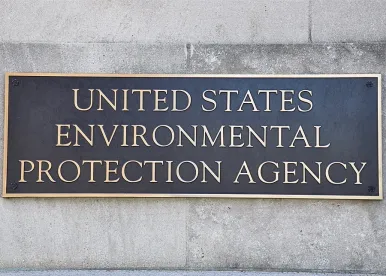Chemicals Under Increasing Scrutiny
This past Valentine’s Day, U.S. Environmental Protection Agency (EPA) Acting Administrator Andrew Wheeler announced EPA’s action plan for regulating per- and polyfluoroalkyl Substances (PFAs), which are a class of synthetic chemicals that have come under increasing scrutiny.
The Action Plan is a multipronged strategy whose primary components include (1) establishing a binding drinking water standard under the Safe Drinking Water Act (“SDWA”) for two of the most common types of PFAs – PFOA and PFOS; (2) listing PFOA and PFOS as “hazardous substances” under CERCLA; (3) using the agency’s considerable enforcement authority to require the remediation of soil or groundwater contaminated with PFAs above EPA’s existing health advisory levels of 70 ppt; and (4) continuing to assess the potential health effects associated with PFAs, including so-called “second generation” PFAs.
While EPA heralded its Action Plan as “groundbreaking” and “all-encompassing,” it is not yet clear whether the agency will be able to regulate these chemicals more quickly or stringently than recent – and inconsistent – state-led efforts. There are certainly aspects of the Action Plan that would have real and significant effects for industry: for example, listing PFOA and PFOS as “hazardous substances” under CERCLA would expose potentially responsible parties to joint and several liability for PFOA and PFOS contamination. And EPA can turn its non-binding health advisory levels for PFOA and PFOS into binding cleanup standards if it builds them into an enforcement order for removal work – which it has done in the past.
However, the Action Plan’s centerpiece – an enforceable drinking water standard under the SDWA – is a lengthy and involved process. The first step is a regulatory determination – essentially, a judgment by the agency that a contaminant poses a health risk, occurs in drinking water at levels of public concern, and can be addressed through regulatory action. EPA says it will make a regulatory determination for PFOA and PFOS by the end of 2019. The determination merely sets up step two of the process, which is proposing a binding Maximum Contaminant Level (MCL) for drinking water systems. Once an MCL is established, every public water provider in the United States would be required to test regularly for PFOA and PFOS, treat any water that doesn’t meet the standards, and inform the public about PFOA and PFOS levels in community drinking water sources. But factoring in a public comment process, likely legal challenges, and grace periods for compliance, EPA drinking water MCLs for PFOA and PFOS are likely years away.
In the meantime, states like Michigan, New Jersey and New Hampshire have taken steps to establish drinking water and cleanup standards for PFAs, some at levels much lower levels than EPA’s current health advisory levels. These patchwork state-led efforts are only expected to continue.
Receiving less press, but of potentially greater import, are EPA’s efforts to finalize toxicity assessments for so-called “second generation” PFAs, including GenX, PFBS, PFBA, PFHxA, PFHxS, PFNA, and PFDA, and related state efforts to regulate these chemicals in wastewater and drinking water. These second-generation chemicals have been less thoroughly studied than their precursors (including PFOA and PFOS), but are the subject of the ongoing Fourth Unregulated Chemical Monitoring Rule (UCMR4). The information that EPA has pledged to gather (and release to the public) about this new class of chemicals will likely guide states as they determine regulatory and litigation priorities.






 />i
/>i
